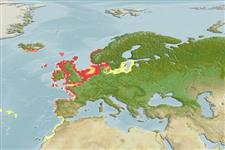>
Eupercaria/misc (Various families in series Eupercaria) >
Labridae (Wrasses)
Etymology: Labrus: Name from Latin 'labrum' for lip, rim or edge; referring to the big lips of the fishes of the genus (from Ovid and Pliny according to Petrus Artedi)..
Environment: milieu / climate zone / depth range / distribution range
Ecologie
marien rifbewoner; diepte 1 - 50 m (Ref. 5292), usually 2 - 30 m (Ref. 35388). Temperate; 64°N - 27°N, 32°W - 22°E
Eastern Atlantic: Norway to Morocco, including Madeira, the Azores and the Canary Islands. Doubtful reports from Mediterranean, Adriatic and Marmara seas (Ref. 4742), where it is often confused with Labrus merula.
Lengte bij maturiteit / Grootte / Gewicht / Leeftijd
Maturity: Lm ? range ? - ? cm
Max length : 65.9 cm TL mannelijk / geslacht onbekend; (Ref. 40637); common length : 50.0 cm SL mannelijk / geslacht onbekend; (Ref. 4742); max. gepubliceerd gewicht: 4.4 kg (Ref. 40637); max. gerapporteerde leeftijd: 29 Jaren (Ref. 6843)
Body rather massive. Mouth small with thick lips and large conical teeth. Coloration very variable, brownish and greenish predominating (Ref. 35388).
Adults are found in littoral (10-20 m) zone around rocks, offshore reefs, and seaweed. Young often in intertidal areas. All are born females and change sex when they are 4-14 years old (Ref. 35388). One (or more) female spawns in nest of algae, built by male in a crevice. Feed on crustaceans and mollusks (Ref. 4742). Oviparous (Ref. 205).
Eggs are laid in nest built from algae; male guards nest 1-2 weeks until larvae hatch (Ref. 35388); larvae are pelagic.
Quignard, J.-P. and A. Pras, 1986. Labridae. p. 919-942. In P.J.P. Whitehead, M.-L. Bauchot, J.-C. Hureau, J. Nielsen and E. Tortonese (eds.) Fishes of the north-eastern Atlantic and the Mediterranean. UNESCO, Paris. Vol. 2. (Ref. 4742)
Status op de Rode Lijst van het IUCN (Ref. 130435)
Gevaar voor de mens
Harmless
Gebruik door de mens
Visserij: visserij voor eigen gebruik; sportvis: ja; Aquarium: Commercieel
Meer informatie
ReferentiesAquacultuurAquacultuurprofielKweeklijnenGeneticaElectrophoresesErfelijkheidZiektesVerwerkingNutrientsMassaconversie
Tools
Speciale rapporten
Download XML
Internetbronnen
Estimates based on models
Preferred temperature (Ref.
123201): 8.7 - 13.3, mean 10.5 °C (based on 376 cells).
Fylogenetische diversiteitsindex (Ref.
82804): PD
50 = 0.5625 [Uniqueness, from 0.5 = low to 2.0 = high].
Bayesian length-weight: a=0.00955 (0.00546 - 0.01671), b=3.07 (2.92 - 3.22), in cm total length, based on LWR estimates for this species & (Sub)family-body (Ref.
93245).
Trofisch niveau (Ref.
69278): 3.2 ±0.0 se; based on diet studies.
Weerstandsvermogen (Ref.
120179): laag, minimale populatieverdubbelingstijd 4,5-14 jaar (K=0.1; tmax=29; tm=2-9).
Fishing Vulnerability (Ref.
59153): High to very high vulnerability (67 of 100).
Climate Vulnerability (Ref.
125649): High to very high vulnerability (75 of 100).
Nutrients (Ref.
124155): Calcium = 10.7 [4.4, 18.8] mg/100g; Iron = 0.168 [0.091, 0.360] mg/100g; Protein = 18.7 [15.8, 21.0] %; Omega3 = 0.302 [0.162, 0.565] g/100g; Selenium = 7.99 [3.73, 17.31] μg/100g; VitaminA = 54.7 [13.8, 262.4] μg/100g; Zinc = 0.647 [0.426, 1.163] mg/100g (wet weight);
